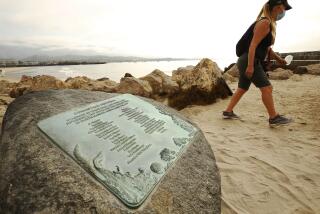Probers Blame Aloha Airline in Fatal Accident : Safety Board Criticizes Maintenance Work, Sees Laxity by FAA, Boeing
WASHINGTON — The National Transportation Safety Board Tuesday primarily blamed Aloha Airlines’ maintenance program for an accident last year in which the roof of a Boeing 737 ripped open over Hawaii, killing a stewardess and imperiling 94 others on board.
On a 4-1 vote, the safety officials found after a 13-month investigation that laxity at both the Federal Aviation Administration and the Boeing Co. also had contributed to the loss of an 18-foot section of the jetliner’s fuselage.
Specifically, the board laid the accident’s “probable cause” to the failure of Aloha’s maintenance workers to detect cracks around rivets in the 19-year-old fuselage. It said that the airline’s management did not “supervise properly its maintenance force.”
In addition, the board criticized the FAA for failing to “evaluate properly Aloha Airlines’ maintenance program and to assess the airline’s inspection and quality control deficiencies.”
Inaction on Lap Joints
It further cited the FAA for failure to require inspection of fuselage lap joints, as had been proposed by Boeing in an “alert service bulletin.”
And the board suggested that the FAA and Boeing should have taken corrective action after the discovery of early production difficulties in the bonding of lap joints on 737 fuselages.
The safety officials made 21 recommendations to the FAA, Aloha and the rest of the airline industry for improving maintenance and inspection programs. Although the safety board does not have the power to enforce its recommendations, the FAA and the airlines nearly always follow its advice.
Investigators said that sweeping action by the FAA last week, including ordering $142 million in modifications to older Boeing 727s, 737s and 747s, should go far toward preventing catastrophic failures on aging airliners of the sort that struck the Aloha craft.
In a major change of philosophy, the agency said that the modifications would have to be made when planes reach a certain age or complete a certain number of flights--not merely when inspections turn up problems, the former policy.
Stewardess Killed
In the Aloha accident of April 28, 1988, a stewardess was killed when she was swept out through a gaping hole in the plane’s fuselage. Of the other 94 persons on board, 61 passengers and crew members were injured, but the pilot managed to land the airliner safely at Kahului airport on Maui. The plane had been flying at 24,000 feet en route from Hilo to Honolulu.
Safety board investigators examined the roles of metal fatigue, aircraft design, airline maintenance, crew performance and FAA directives affecting the aircraft, which had logged nearly 90,000 flights.
During a daylong meeting, metallurgist James Wildey told the board that a 3-by-4-foot piece of metal skin from the plane showed that it had been repaired but still contained cracks that were missed by airline mechanics before the accident.
“The piece that they repaired contained additional fatigue cracks that were underneath the repair patches, between the repair patches and on either side of the repair patches,” Wildey said.
Aloha’s president and chief executive officer, A. Maurice Myers, said the airline “took exception” to that analysis, adding that there was “substantial evidence that those multiple cracks were not detectable.”
Myers noted that close inspections after the Aloha incident uncovered similar cracks in a number of other aging Boeing 737s and said: “This is an industry-wide problem that has already been addressed by the industry and the FAA.”
Safety board member Joseph Nall adopted the same position. He dissented from the board’s assignment of blame, saying that he thinks that responsibility should be spread across the airline system for its failure to deal earlier with the problem of aging airliners.
Board member Jim Burnett cited indications that the FAA had not followed recommendations from the plane’s manufacturer in issuing maintenance directives to airlines.
He noted that one Boeing service bulletin had directed airlines to replace rivets along the fuselage even before the Aloha 737 split open. But an FAA airworthiness directive was vague in its requirements, he said.
“The real issue is that (the FAA) didn’t follow through on Boeing alert service bulletins,” Burnett added.
Chief safety board inspector Barry Trotter said that Aloha has improved its maintenance program since the accident.
Myers contended that the airline was “in full compliance with FAA requirements and industry standards at the time” of the accident and has since made many changes.
Aloha has scrapped three of its 737s, including the one that ripped open, and purchased several new planes, giving its fleet an average age of 10 years, compared with 15 at the time of the accident.
More to Read
Inside the business of entertainment
The Wide Shot brings you news, analysis and insights on everything from streaming wars to production — and what it all means for the future.
You may occasionally receive promotional content from the Los Angeles Times.










